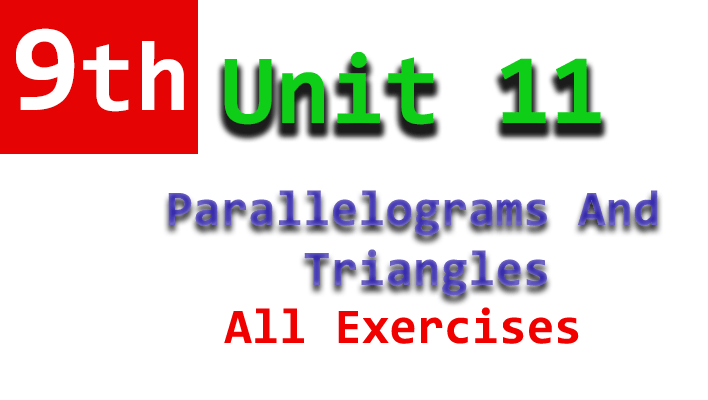Unit 11: Parallelograms and Triangles! This unit explores the fascinating properties and relationships between parallelograms and triangles. Parallelograms are special quadrilaterals with unique attributes, while triangles are fundamental polygons that form the basis of much of geometry. In this unit, we will dive deep into the theorems and properties that govern parallelograms and triangles, revealing their hidden secrets and connections.
Exercise 11.1
Exercise 11.2
Exercise 11.3
Exercise 11.4
- Chapter No.1 Introduction to Biology
- Chapter No. 2 Solving a Biological Problem
- Chapter No.3 Biodiversity
- Chapter No.4 Cells and Tissues
- Chapter No.5 Cell Cycle
Exercise 11.5
Review Exercise
Section 11.1: Parallelograms and Triangles
This section lays the groundwork for exploring the properties of parallelograms and triangles. Before delving into the theorems, students will be advised to recall the definitions of polygons like parallelogram, rectangle, square, rhombus, trapezium, and particularly triangles and their congruency. Having a solid understanding of these concepts is essential for the proofs that follow.
Theorem 11.1.1: Properties of Parallelograms
In this theorem, we will prove several fundamental properties of parallelograms:
Opposite Sides of a Parallelogram are Congruent: If a quadrilateral has two pairs of opposite sides that are congruent and parallel, then it is a parallelogram.
Opposite Angles of a Parallelogram are Congruent: The opposite angles of a parallelogram are congruent.
Diagonals of a Parallelogram Bisect Each Other: The diagonals of a parallelogram bisect each other at their point of intersection.
Theorem 11.1.2: Properties of Triangles
This theorem explores the properties of triangles:
Midpoint Theorem: The line segment joining the midpoints of two sides of a triangle is parallel to the third side and equal to half of its length.
Medians of a Triangle: The medians of a triangle are concurrent, and their point of concurrency is the centroid, which is also the point of trisection of each median.
Theorem 11.1.3: Parallel Lines and Transversals
This theorem focuses on the relationships between parallel lines and transversals:
If three or more parallel lines make congruent segments on a transversal, they also intercept congruent segments on any other line that cuts them.
Unit 11: Parallelograms and Triangles is a crucial module in the geometry curriculum, providing students with valuable insights into the properties of parallelograms and the fascinating relationships within triangles. By understanding and proving these theorems, students will enhance their geometric reasoning and problem-solving skills.
The knowledge gained from this unit extends beyond geometry, as parallelograms and triangles have applications in various fields, such as architecture, engineering, and design. The ability to recognize and utilize the properties of these shapes empowers students to approach complex geometric problems with confidence and precision.
As students progress through this unit, they will develop a deeper appreciation for the elegance of geometry and the interplay between shapes and angles. The skills acquired in this unit will pave the way for further exploration of advanced geometry concepts and instill a sense of wonder and curiosity in the captivating world of mathematics.

